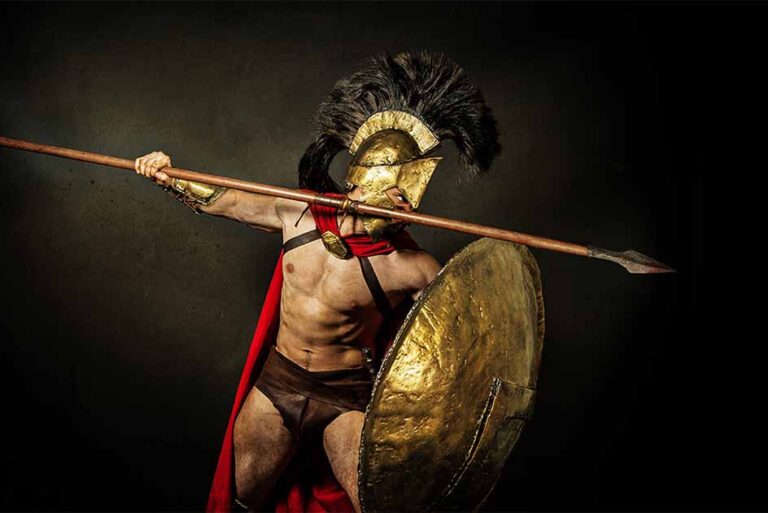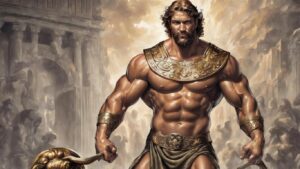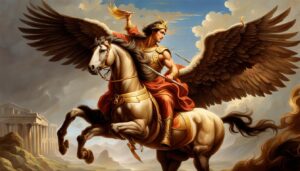Table of Contents
Who Is Achilles?
Parentage: Achilles was the son of Thetis, a sea nymph, and Peleus, a mortal king. Thetis tried to make Achilles immortal by dipping him in the River Styx, holding him by his heel. As a result, his heel remained vulnerable, and it would later become his fatal weakness.
Warrior in the Trojan War: Achilles played a significant role in the Trojan War, a legendary conflict between the Greeks and the Trojans. He was a leader of the Myrmidons, a group of fierce Greek warriors. However, he withdrew from the battle after a dispute with Agamemnon, the Greek commander, over a captured maiden, Briseis.
Rage and Wrath: The “Iliad” opens with Achilles’ anger sparked by Agamemnon’s deeds, and the epic extensively explores the repercussions of his rage on the Greek forces. His fury prompts his withdrawal from battle, causing significant suffering for the Greeks.
Patroclus: Patroclus, Achilles’ dearest companion, met his demise at the hands of Hector, the Trojan prince, in Achilles’ absence from the battlefield. Consumed by grief and anger, Achilles reentered the war, driven by the determination to avenge Patroclus’s death.
Death: In the “Iliad,” Achilles kills Hector and eventually meets his own demise when he is shot in the heel by Paris, guided by the god Apollo. His heel was the one vulnerable spot on his body due to his mother’s earlier attempt to make him immortal. This incident is the origin of the expression “Achilles’ heel,” referring to a person’s weakness.
Achilles is a complex and multifaceted character in Greek mythology. He embodies the heroic ideal but also serves as a cautionary example of the destructive power of anger and pride. His story has inspired countless works of art, literature, and drama and remains a central figure in Western literary and cultural tradition.
Achilles characteristics
Achilles is a complex and multifaceted character in Greek mythology, and his characteristics reflect the various dimensions of his persona as portrayed in the “Iliad” and other ancient texts. Here are some key characteristics and qualities associated with Achilles:
Bravery and Valor: Achilles, celebrated for his exceptional courage and battlefield prowess, stands as one of the Trojan War’s greatest warriors. He embodies the Greek ideal of martial excellence.
Achilles’ Wrath: One of his most prominent characteristics is his intense and consuming anger, which is central to the plot of the “Iliad.” A dispute with Agamemnon over a captured maiden triggers his wrath, resulting in significant consequences for the Greek forces.
Achilles’ Pride: His immense pride and sense of honor are defining traits. He is highly sensitive to perceived slights and injustices, and this pride often leads to conflicts with other Greek leaders and warriors.
Loyalty and Friendship: Achilles has a deep and loyal friendship with Patroclus, his closest companion. This relationship is a key aspect of his character and plays a pivotal role in the epic.
Human Vulnerability: Despite his extraordinary strength and skills, Achilles is not invulnerable. His heel, which was not immersed in the River Styx when his mother attempted to make him immortal, is his one vulnerable point. This vulnerability ultimately leads to his death.
Moral Complexity: Achilles is not a one-dimensional hero. He grapples with complex moral and emotional issues, including the ethics of war, the value of honor, and the consequences of his actions.
Empathy and Grief: Despite his fierce exterior, Achilles is capable of deep empathy and grief. The death of Patroclus brings forth profound sorrow and a desire for revenge.
Mourning Ritual: After the death of Patroclus, Achilles engages in elaborate mourning and funeral rites, displaying a sense of cultural and religious tradition.
Leadership and Charisma: He is a charismatic leader of the Myrmidons and inspires his troops with his presence and heroic deeds.
Heroic Ideal: Achilles embodies the heroic ideal of ancient Greece, representing the virtues of physical strength, courage, and honor.
Origins of Achilles
Parentage: Thetis and Peleus are the parents of Achilles. Thetis was a sea nymph and a minor deity associated with the sea. Peleus was a mortal king and the son of Aeacus. Thetis and Peleus were married against the wishes of the gods, and their union produced Achilles.
A Goddess as Mother. Several gods courted Thetis initially, drawn by the prophecy that her son would surpass his father. Zeus and Poseidon, powerful deities, vied for her hand. However, Zeus orchestrated her marriage to a mortal, preventing the birth of a divine child that could challenge the gods.
The Styx Baptism: Thetis, fearing for Achilles’ safety in battle, attempted to make him immortal. She dipped him in the sacred river Styx while holding him by his heel, which left that part of his body vulnerable. This incident is the origin of the term “Achilles’ heel,” signifying a person’s vulnerability or weak point.
Achilles is a central figure in Greek mythology, and his story has been a subject of fascination and inspiration for countless generations. His origins are rooted in the complex relationships between gods and mortals, and his character embodies both the heroic and tragic elements of Greek mythology.
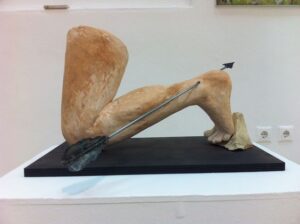
Legends and Stories Immortality The Trojan War Death
Quest for Immortality: One of the most famous stories about Achilles revolves around his quest for immortality. According to mythology, Achilles’ mother, Thetis, tried to make him immortal by dipping him in the River Styx, holding him by the heel. The waters of the Styx were believed to convey invulnerability. However, because she held him by the heel, that part of his body remained vulnerable. This vulnerability ultimately led to his downfall and is the origin of the phrase “Achilles’ heel,” signifying a person’s weakness.
The Trojan War: Achilles, a central figure in the legendary Trojan War, participated in the conflict between the Greeks (Achaeans) and the Trojans. Notably, his rage and subsequent withdrawal from battle are significant themes in Homer’s epic poem, the “Iliad.” Regarded as one of the Greeks’ greatest warriors, his absence severely weakened their forces. This anger arose from a dispute with Agamemnon regarding the captured maiden, Briseis. Following the death of his close companion Patroclus at Hector’s hands, Achilles returned to the war with a determination to avenge his friend’s death. Ultimately, he slew Hector, playing a critical role in the Greeks’ triumph over the Trojans.
Death: Achilles’ story ends tragically. He was killed during the Trojan War by Paris, guided by Apollo. Paris shot an arrow into Achilles’ heel, the one vulnerable spot on his body due to his mother’s earlier attempt to make him immortal. This wound was fatal, and Achilles died in battle. His death marks the conclusion of his heroic journey and is a pivotal moment in the narrative of the Trojan War.
Achilles’ legends and stories continue to be a source of inspiration and fascination in literature, art, and popular culture. His character embodies the complexities of heroism, vulnerability, and mortality, making him a timeless figure in Greek mythology.
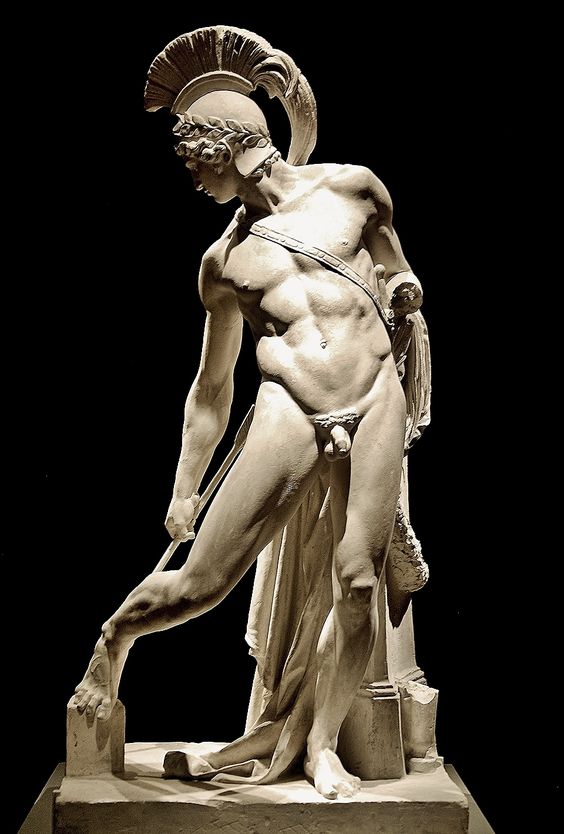
Appearance
General Characteristics:
Armor and Weapons:
Frequently portrayed, Achilles wears armor, including a helmet and a breastplate. He is often depicted carrying a spear and a round shield.
Attributes:
One distinctive feature that artists and authors often emphasize is Achilles’ heroic and powerful presence.
Attributes symbolizing his warrior status and invincibility in battle are commonly depicted with him.
Achilles’ appearance can vary in different representations of the myth. Ancient Greek texts, emphasizing actions and emotions, are the primary sources. The mentioned descriptions are artistic conventions in later portrayals.
Symbology
Achilles’ Shield: In Homer’s “Iliad,” Achilles’ shield holds profound symbolism. Meticulously detailed, it represents diverse aspects of Greek culture, society, and the hero’s values. Moreover, the shield symbolizes broader themes such as honor, warfare, civilization, and the cosmos.
Achilles’ Spear: His spear is another important symbol. It represents his martial prowess and is often associated with his role as a warrior.
The Achilles’ Heel: Perhaps the most famous symbol associated with Achilles is his vulnerable heel. The term “Achilles’ heel” has become a widely recognized symbol of a person’s weakness or vulnerability.
The Myrmidons: Achilles led a group of warriors known as the Myrmidons. They can symbolize loyalty, martial skill, and heroism.
The Pelian Ash Tree: According to some versions of the myth, Achilles’ mother, Thetis, dipped him in the River Styx while holding him by the heel. The Pelian Ash tree was said to be the source of the wood used for his mother’s fire. This tree can represent the element of immortality and mortality in Achilles’ story.
The Greek Heroic Ideal: Achilles is frequently viewed as the embodiment of the Greek heroic ideal. His character and actions symbolize the values of bravery, honor, excellence in battle, and the pursuit of glory.
The Wrath of Achilles: Achilles’ anger and its consequences in the “Iliad” are symbolic of the destructive power of emotions and the costs of unchecked rage in both personal and societal contexts.
These symbols and elements associated with Achilles reflect the complex and multifaceted nature of his character and the broader themes explored in Greek mythology and literature. Achilles is not only a legendary warrior but also a symbol of heroism, honor, vulnerability, and the human condition.
Achilles FAQ
What is Achilles the God of?
Achilles is not a god but a mortal hero. He is known for his exceptional skill in battle and his central role in the Trojan War.
What Did Achilles Look Like?
Achilles is often depicted as a youthful and muscular warrior with blonde or golden hair. Specific details vary in different artistic representations.
Who Killed Achilles?
Achilles was killed by Paris, guided by the god Apollo, during the Trojan War. He was shot in the heel, his only vulnerable spot.
What is Achilles' Heel?
Achilles' heel refers to his one vulnerability. According to myth, his mother, Thetis, held him by the heel when she dipped him in the River Styx, leaving that spot unprotected.
How Did Achilles Die?
Achilles died from a wound to his heel inflicted by Paris, with Apollo's guidance, during the Trojan War.
Who is Achilles' Mother?
Achilles' mother is Thetis, a sea nymph.
Who Was the Father of Achilles?
The father of Achilles is Peleus, a mortal king.
How Old Was Achilles When He Died?
The age of Achilles at the time of his death is not explicitly mentioned in the myths.
Where Was Achilles From?
Achilles is associated with Thessaly, a region in ancient Greece.
Why Did Achilles Kill Hector?
Achilles killed Hector in revenge for Hector's killing of Achilles' close friend, Patroclus, during the Trojan War.
How Tall Was Achilles?
There is no specific mention of Achilles' height in ancient texts.
Who Was Achilles' Lover?
In some interpretations, Achilles' closest companion, Patroclus, is considered his lover.
When Was Achilles Born?
The birthdate of Achilles is not specified in ancient mythology.
Who Trained Achilles?
Achilles was trained by the centaur Chiron, known for his wisdom and skill in teaching heroes.
Who Did Achilles Fight For?
Achilles fought for the Greeks (Achaeans) during the Trojan War.
Which Greek Goddess Gave Aid to Achilles During the Trojan War?
Thetis, Achilles' mother, sought the aid of Hephaestus, the god of craftsmanship, who provided Achilles with new armor.
Who Did Achilles Love?
Achilles' deepest emotional connection was with Patroclus, his close friend and companion.
